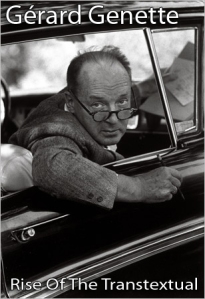 In my most recent searches into the void I have come across the concept/theory/ideology of transtextuality. Right off the bat I was hooked. "What the hell is transtextuality?" "What the hell is transtextuality?" "What the hell is transtextuality?" This has become my internal mantra. I have scoured the net and found many theorys and writings at length upon the subject, but every addition to this new current literary trend leaves the hallmark question answered by yet another question. Still undefined and awash of speculation built upon few source materials, I am so drawn towards this emerging classification of communication. The deeper I fall down this rabbit hole the stronger my current realization become...I am a transtextual.
In my most recent searches into the void I have come across the concept/theory/ideology of transtextuality. Right off the bat I was hooked. "What the hell is transtextuality?" "What the hell is transtextuality?" "What the hell is transtextuality?" This has become my internal mantra. I have scoured the net and found many theorys and writings at length upon the subject, but every addition to this new current literary trend leaves the hallmark question answered by yet another question. Still undefined and awash of speculation built upon few source materials, I am so drawn towards this emerging classification of communication. The deeper I fall down this rabbit hole the stronger my current realization become...I am a transtextual.Transtextuality was originally coined by Gérard Genette in his book Palimpsests which can be found within the Google Books library. Of course, being ever so busy attempting to fool myself and everyone else into believing that I am the budding erudite, I have not read Genette's book...yet. Despite this minor roadblock in time management, I see no reason as to hold back my insightful take on the whole transtextuality thing. There is a plethora of regurgitation amongst the blogashere on Genette's concepts; here is the gist of it all. According to helmer.ca there are four sub-categories of transtextuality. They include intertexuality, paratextuality, architextuality, and hypotextuality. this is the comman basis for the breakdown of the trantextuality within the multiple net pages dedicated to it's definable understanding, though some sources do interchange intertextuality for metatextuality but their definitions remain identical. Intertextuality and or metatextuality refers to the concept of one text referring to itself as well as a secondary text referring to a primary text where in the understanding of the secondary text helps to define the primary text. Paratextuality is the textual information that surrounds and or supports the main text. this can be defined through the uses of specific fonts, illustrations, embedded videos and audio files, headings, prefaces, dedications, footnotes, and ect. Architextuality comments on related texts connected through genre. this definition I find a bit elusive but it's terms are easier understood as helmer.ca puts it "the division of a play into acts". Finally, hypotextuality refers to a secondary text that supports a primary text by creating interjections into the original text. I understand this concept most clearly in regards to the modern phenomenon of the remix and remix culture. Essentially that is the basis for the transtextual, all originally conceived by Genette and published in France in 1982 but it's prime importance is just now being conceptually understood and practiced through the renaissance of new media.
Currently, rhetoricians are revisiting Genette's proposed transtextuality and correlating it to modern communication modes and means. The ideals of transtextuality are specifically the fundamental elements of new media communication. all four of the predefined transtextual sub-categories are explicitly utilized within current new media trends. As the lines between consumer and creator are becoming ever so blurred transtextuality is becoming the norm. Within my own interpretations of the subject, this new media revolution is slated to make transtextuals out of us all. We are collectively referring to and morphing texts upon texts. Within the bounds of social media we are creating volumes upon volumes of text genre all of which intesects and interprets one another anew. many of the new media artists and designers are basing their work on cross platfomisation as remix of idea, concept, and content lead towards new contextualizations. personally I feel that the crux of transtextuality lies within the unfettered bounds our new media. We are still in the fledgling infancy of our "new printing press". we are all still learning to typeset our new communicative paradigm. This new openness and availability towards active communication lends itself towards the concepts of transtextuality. It is time to open the closet door and embrace our transtextual tendencies.

No comments:
Post a Comment